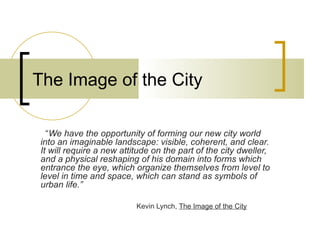The image of the city presentation hogan
•Download as PPT, PDF•
0 likes•2,073 views
Report
Share
Report
Share

Recommended
Recommended
More Related Content
Viewers also liked
Viewers also liked (17)
The Image of the Data City: Perception in Shared Information Spaces

The Image of the Data City: Perception in Shared Information Spaces
The City in the Image. On the Architecture of Urban Landscape

The City in the Image. On the Architecture of Urban Landscape
Recently uploaded
Recently uploaded (20)
Integrating Telephony Systems with Salesforce: Insights and Considerations, B...

Integrating Telephony Systems with Salesforce: Insights and Considerations, B...
FDO for Camera, Sensor and Networking Device – Commercial Solutions from VinC...

FDO for Camera, Sensor and Networking Device – Commercial Solutions from VinC...
TEST BANK For, Information Technology Project Management 9th Edition Kathy Sc...

TEST BANK For, Information Technology Project Management 9th Edition Kathy Sc...
Easier, Faster, and More Powerful – Alles Neu macht der Mai -Wir durchleuchte...

Easier, Faster, and More Powerful – Alles Neu macht der Mai -Wir durchleuchte...
ASRock Industrial FDO Solutions in Action for Industrial Edge AI _ Kenny at A...

ASRock Industrial FDO Solutions in Action for Industrial Edge AI _ Kenny at A...
Linux Foundation Edge _ Overview of FDO Software Components _ Randy at Intel.pdf

Linux Foundation Edge _ Overview of FDO Software Components _ Randy at Intel.pdf
PLAI - Acceleration Program for Generative A.I. Startups

PLAI - Acceleration Program for Generative A.I. Startups
How Red Hat Uses FDO in Device Lifecycle _ Costin and Vitaliy at Red Hat.pdf

How Red Hat Uses FDO in Device Lifecycle _ Costin and Vitaliy at Red Hat.pdf
What's New in Teams Calling, Meetings and Devices April 2024

What's New in Teams Calling, Meetings and Devices April 2024
Your enemies use GenAI too - staying ahead of fraud with Neo4j

Your enemies use GenAI too - staying ahead of fraud with Neo4j
Powerful Start- the Key to Project Success, Barbara Laskowska

Powerful Start- the Key to Project Success, Barbara Laskowska
Easier, Faster, and More Powerful – Notes Document Properties Reimagined

Easier, Faster, and More Powerful – Notes Document Properties Reimagined
Introduction to FDO and How It works Applications _ Richard at FIDO Alliance.pdf

Introduction to FDO and How It works Applications _ Richard at FIDO Alliance.pdf
Portal Kombat : extension du réseau de propagande russe

Portal Kombat : extension du réseau de propagande russe
Continuing Bonds Through AI: A Hermeneutic Reflection on Thanabots

Continuing Bonds Through AI: A Hermeneutic Reflection on Thanabots
The image of the city presentation hogan
- 1. The Image of the City “We have the opportunity of forming our new city world into an imaginable landscape: visible, coherent, and clear. It will require a new attitude on the part of the city dweller, and a physical reshaping of his domain into forms which entrance the eye, which organize themselves from level to level in time and space, which can stand as symbols of urban life.” Kevin Lynch, The Image of the City
- 2. The City and Its Elements Landmarks Paths Districts Nodes Edges
- 3. Landmarks “Landmarks are another type of point reference, but in this case the observer does not enter within them, they are external. They are usually a rather simple defined physical object: building, sign, store, or mountain. Their use involves the singling out of one element from a host of possibilities. Some landmarks are distant ones, typically seen from many angles and distances, over the tops of smaller elements, and used as radial references. They may be within the city or at such a distance that for all practical purposes they symbolize a constant direction. Such are isolated towers, golden domes, great hills. “
- 4. Paths “Paths are the channels along which the observer customarily, occasionally, or potentially moves. They may be streets, walkways, transit lines, canals, railroads. For many people, these are the predominant elements in their image. People observe the city while moving through it, and along these paths the other environmental elements are arranged and related. “
- 5. Districts “Districts are the medium-to-large sections of the city conceived as having two-dimensional extents, which the observer mentally enters “inside of” and which are recognizable as having some common identifying character. Always identifiable from the inside, they are also used for exterior reference if visible from the outside. Most people structure their city to some extent in this way, with individual differences as to whether paths or districts are the dominant elements. It seems to depend not only upon the individual, but also upon the given city.”
- 6. Nodes “Nodes are points, the strategic spots in a city into which an observer can enter, and which are the intensive foci to and from which he is traveling. They may be primary junctions, places of a break in transportation, a crossing or convergence of paths, moments of shift from one structure to another. Or the nodes may be simply concentrations, which gain their importance from being the condensation of some use or physical character, as a street corner hangout or an enclosed square.”
- 7. Edges “Edges are the linear elements not used or considered as paths by the observer. They are the boundaries between two phases, linear breaks in continuity: shores, railroad cuts, edges of development walls. They are lateral references rather than coordinate axes. Such edges may be barriers, more or less penetrable, which close one region from another; or they may be seams, lines along which two regions are related or joined together. These edge elements, although probably not as dominant as paths, are for many people important organizing features, particularly in the role of holding together generalized areas, as in the outline of a city by a water feature.”